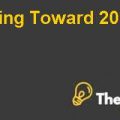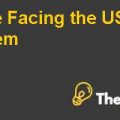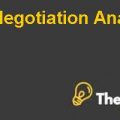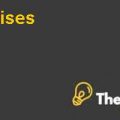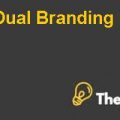Capital Structure and Firm Performance: Evidence from Airline Industry of USA Case Solution
Data Analysis
Multiple data analysis using least square method is used for our study. In order to test the effect of capital structure on firm performance, following the models are being used.
ROA denotes return on assets, for which we have used proxy variables and c is the x-intercept of the equation. Return on Assets (ROA) denote capital structure leverage ratio (total debt/ total equity), moreover, firm size, tangibility and risk factors are analyzed to check the impact on return in overall industry.
Results
Descriptive Statistics
In case of Firm performance, we are using proxy variable i.e. Return on Assets (ROA), RO. Which help us to find effect of capital structure on firm performance in Airline industry of USA during the period of 2013 to 2017. The mean of ROA was 0.08 or 8% for the period and standard error was 0.01. Minimum and maximum values for ROA were -4% to 18%, which shows the variability in earning in the industry. If we look at the mean of Leverage which is 3.39, this tells us that the American Airline industry has very high debt in their capital structure and more leveraged, where the range of total debt to total equity was -16.49 to 20.40. In addition, firm size analyzed using log of sales of the companies in the airline industry, mean for firm size is 2.78, which ranged from 1.60 to 3.75.
Moreover, as tangibility of assets was analyzed using ratio of total fixed assets with that of total assets. The mean of the ratio was 0.70, which shows the high fixed assets in the industry and the range was from 19% to 88%, which means that the weight of fixed assets was very significant as compare to current assets. At last, the risk factor was used to analyze variability in the cash flows. The mean standard deviation of cash flows was 1.21 and it ranged from minimum of 0.01 to maximum of 6.89, which is an indication of huge variability in the earning of major airlines of USA.
Correlation Analysis
The correlation coefficients used in the regression are given in the table, which shows that the correlation between ROA, which is our dependent variable is positively correlated with only one variable i.e. leverage and is negatively correlated with all other independent variables.
In case of leverage it has positive correlation with that of firm size and tangibility but it is significantly correlated with risk, because the correlation coefficient was more than 0.5. Moreover, firm size is significantly correlated with tangibility and risk, where it is still positively correlated with leverage. Tangibility has a negative correlation with ROA and is positively correlated with rest of the variables. Same is for risk, which is positively correlated with all the variables except ROA.
Panel data Regression Results
In our analysis of capital structure and firm performance, we have used Linear Regression for our panel data of firms from Airline Industry of USA for the time period of 2013 to 2017. First of all we have used our dependent variable ROA and observed the impact of other independent variables on ROA. We used E-Views for developing and analyzing the equation.
The results which we found from E-Views were as follow,
| R^2 = | 0.14 |
| Adjusted R^2 = | -0.09 |
The R^2 of our model remained very low due to limiting our analysis to leverage, firm size, risk and tangibility, as there are other variables which also impact on the Return on Assets (ROA) i.e. 14%, which means that, on average our independent variables are explaining 14% of the overall change in ROA due to change in independent variable.
As per the equation, only firm size has a positive impact on firm performance (ROA), where its coefficient is very low, which shows that the impact of firm size on firm performance is positive but is very low. Moreover, the impact of leverage is negative on firm performance, which means that increase in debt is adversely impacting the firm performance and its coefficient is again very low. Now, if we see the impact of tangibility and risk on firm performance, it is again negative and there coefficients are -2.3% and -.31%, where tangibility has more impact on firm performance.
Conclusion
As per the results of our analysis, there is a negative relationship between capital structure and firm performance. Moreover, the risk and tangibility also impacted the firm performance adversely. The only variable which has a positive impact on firm’s performance in Airlines Industry of United States is firm size, as when the firm size is larger, it becomes more likely that the firm will avoid loses. But overall, when a company increases its debt over equity, its performance started to decline. In addition, this declining performance can also be seen if firm in the airline industry of America has more variance in its cash flows and which significantly increases its fixed asset portion of the balance sheet.
So, our results are consistent with that of studies of (Moyer, 1997). Where they found the negative relationship between the debt to equity ratio (leverage) and the company performance through return of assets (ROA).
Moreover, our results are also consistent with that of the study conducted by (ALTMAN, 1984), where they found that, if the proportion of debt in capital structuring increases beyond the acceptable level than the opposite effect of this high leveraged company will upon its agency cost because in this situation, managers may take actions in their own interests by using the money of shareholders, so, here, the conflict of interest will arise and company losses its overall performance..........
This is just a sample partical work. Please place the order on the website to get your own originally done case solution.


